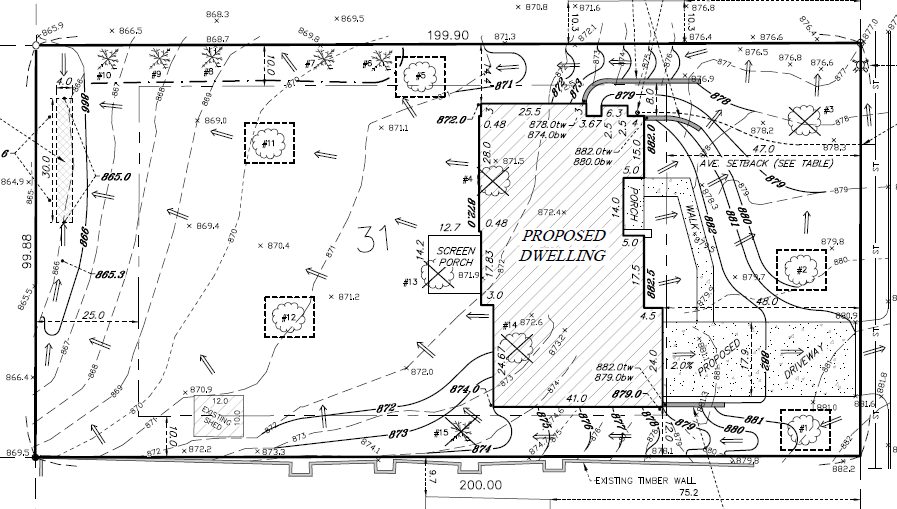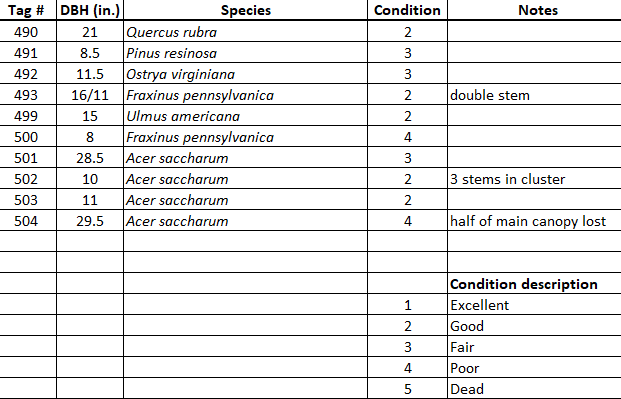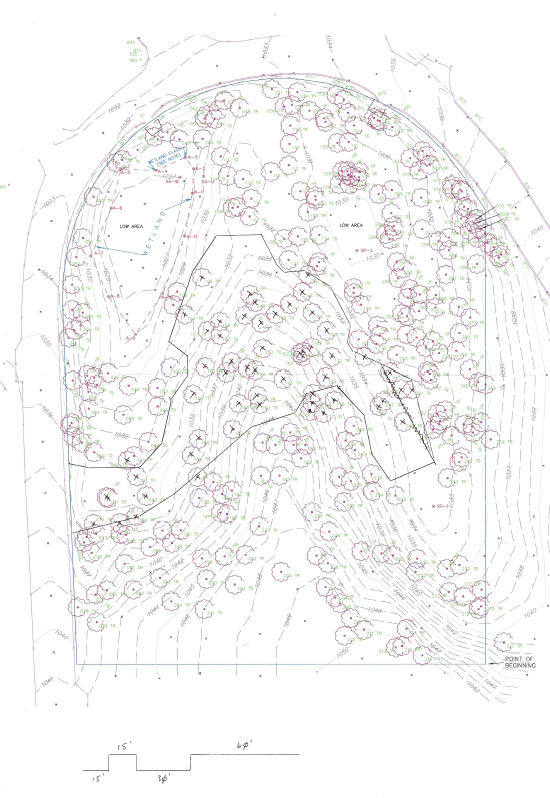Tree Preservation Plans
Life in the urban environment causes conflicts between humans and the natural environment. But this does not mean people and trees cannot coexist in the same space. Quite the opposite is true. With planning, we can build homes under the canopies of large trees with minimal impact. A “tree preservation plan” protects before, during, and after construction.

This site plan shows proposed tree removals, tree protection measures, grading changes, and the building location.
Why protect trees?
Trees provide significant societal and economic benefits that we may not consider. Not only are healthy trees pleasing, but they provide ecological services. Trees improve water quality, filter pollutants from the air, and provide shade. The economic benefits of trees in the urban environment shouldn’t be overlooked. Healthy trees can boost property values and enhance marketability for homeowners and developers. Studies suggest that healthy, mature trees on a property can increase market values by up to 12%.
Aside from the benefits, preserving a tree is cheaper than treating or removing a damaged one. Soil compaction is the primary cause of tree death after a construction project. Compacted soils have disrupted water and gas exchange capabilities, affecting nutrient availability. Soil compaction suffocates and predisposes trees to disease and insect attacks. As such, protecting a tree may be less expensive than removal, which may cost thousands of dollars. The good news is that you can remediate construction damage. But, the best option is always to prevent tree damage from occurring in the first place.
What is a tree preservation plan?
Many of our municipalities follow this logic and have enacted tree preservation ordinances. There must be a tree preservation plan in place before issuing construction permits. This is to preserve a community’s tree population.
A tree preservation plan begins with an inventory and assessment of the trees. The size of the property will determine whether it requires a full or partial inventory. Partial inventories are standard on significant properties, looking only at the construction area. Assess every tree on the property for species, size, general condition, and location.

An example of a basic tree inventory.
The next step is determining which trees fall under the local preservation ordinance. Identify and mark “Heritage,” “protected,” or “significant” trees. Scout trees that need treatment or removal and plot these on the map as well.
After determining the location of the trees, select the building site. Tree removal may be inevitable, but buildings should accommodate mature trees where possible.
How do we protect trees?
Next, plan how to protect each of these trees. The goal is to defend the “protected root zone.” Determine the protected root zone in one of two ways:
- The area underneath the canopy extends to the “drip line.” The drip line is the edge of the canopy, where rain would drip off the leaves.
- The edge of the “critical root zone.” This is a radius of 1.5 feet per 1 inch of trunk diameter. The critical root zone may extend beyond the drip line of the tree.

This site survey shows trees slated for removal and the location of tree protection fencing.
Protect this root zone, as it becomes “off limits” to any construction activities. A standard method is to install a high-visibility fence around the protected root zone. This physical barrier prevents intrusion by construction activities. Other options include using alternate building materials and creating wood chip pathways to lessen soil compaction.
The next step is to watch and test the effectiveness of the tree protection plan. Visit the building site, and consider:
- Is the size or location of a tree protection zone practical?
- Are tree protection zones acknowledged and regarded?
- Do you need to incorporate other tree protection measures?
What about after construction?
It’s essential to provide your trees with some post-construction care. Soil aeration restores proper drainage and soil structure. Mulch applied from the trunk to the drip line provides long-term benefits. It also goes without saying, but consistent watering will put your trees on track.
A preservation plan ensures that community trees have a presence. It is a simple process with rewarding benefits. For more information about designing a tree preservation plan, contact Vineland Tree Care.
